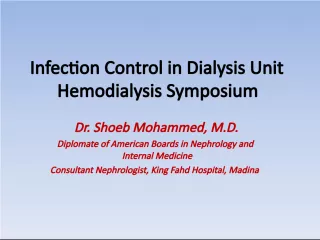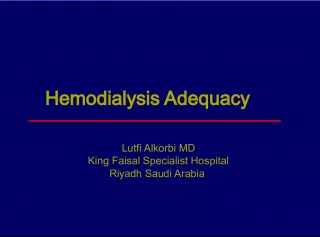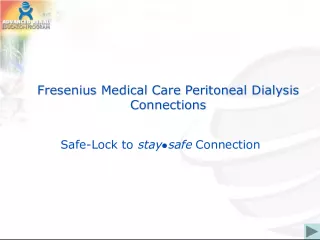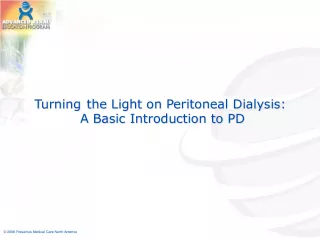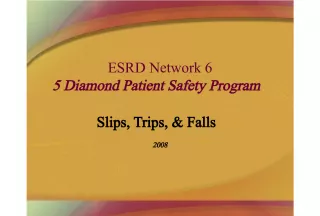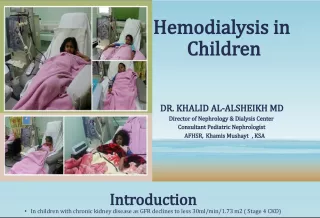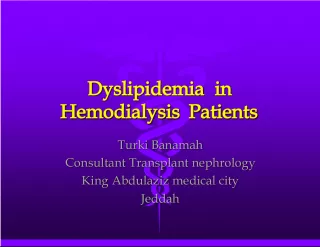Anticoagulation on Dialysis
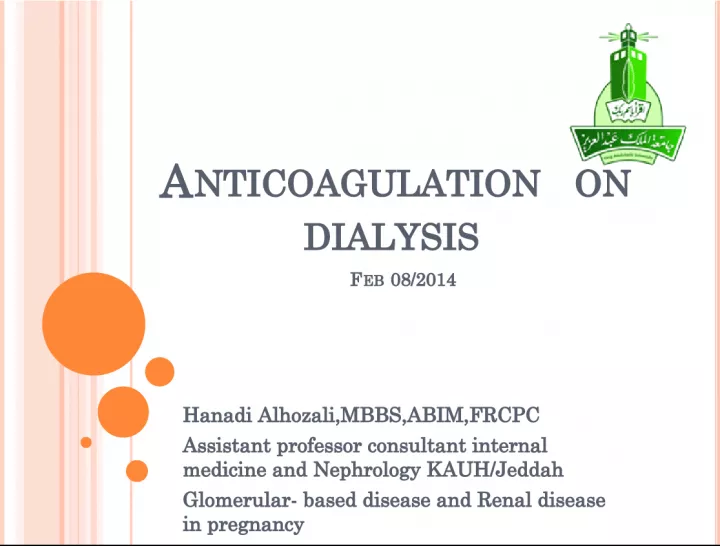

This article discusses hemostatic changes in renal dysfunction and alternative anticoagulation options in dialysis patients at risk of bleeding, including LMWH and heparin-induced thrombocytopenia (HIT).
- Uploaded on | 4 Views
-
 emanuele
emanuele
About Anticoagulation on Dialysis
PowerPoint presentation about 'Anticoagulation on Dialysis'. This presentation describes the topic on This article discusses hemostatic changes in renal dysfunction and alternative anticoagulation options in dialysis patients at risk of bleeding, including LMWH and heparin-induced thrombocytopenia (HIT).. The key topics included in this slideshow are . Download this presentation absolutely free.
Presentation Transcript
1. A NTICOAGULATION ON DIALYSIS F EB 08/2014 Hanadi Alhozali,MBBS,ABIM,FRCPC Assistant professor consultant internal medicine and Nephrology KAUH/Jeddah Glomerular- based disease and Renal disease in pregnancy
2. O BJECTIVES History Hemostatic changes in renal dysfunction. Standard anticoagulation on hemodialysis. Alternative anticoagulation in dialysis patients at increase risk of bleeding. Other anticoagulation: LMWH Heparin-induced thrombocytopenia (HIT)
3. Anticoagulation required during IHD/CRRT to prevent clotting in the extracorporeal service. Anticoagulation crucial to prevent undesirable blood loss and provide constant optimal solute clearance.
4. H ISTORY OF A NTICOAGULATION 1914 Abel developed and tested the first efficient dialysis system in animal at Johns Hopkins University School of Medicine. Their vivi- diffusion apparatus consisted of a filtering device made of cellulose trinitrate (collodion) tubes and an attached burette containing hirudin solution used as anticoagulant. That same year , Hess and McGuigan recommended high blood flows to avoid clotting or need for anticoagulation. Abel J, Roundtree L, Turner B. On the removal of diffusible substances from the circulating blood of living animals by dialysis. J Pharmacol Exp Ther 5:275-316, 1914 Hess J, McGuigan W. The condition of the sugar in the blood. Pharmacology 6:45-55, 1914
5. The first human hemodialysis was performed in a uremic patient by Haas in 1924 at the University of Giessen in Germany. He used a tubular device made of collodion and hirudin for anticoagulation. Haas G. Versuche der Blutauswaschung am Lebenden mit Hilfe der Dialyse. Klin Wochenschrift 4:13, 1925 Benedum J. Pioneer of dialysis, George Haas (1886-1971). Med Hist 14:196- 217, 1979
6. H EMOSTATIC CHANGES IN DIALYSIS Bleeding diathesis: Platelets dysfunction and abnormal platelets endothelial interaction. Uremic toxins, increase NO production and anemia are major contributing factors. Skin and mucosal bleeding(Nasal/GI) and Excessive bleeding after invasive procedure. Normal coagulation (PT/APTT) unless there is coagulopathy. Increase risk of bleeding (prolonged BT) with use of ASA (Cyclooxygenase independent)
7. Thrombosis in dialysis: Dialysis and CKD patients at increase risk for venous thromboembolism and access thrombosis. Chitalia et al;circulation,2013 Jan Wattanaki k et al;JASN,2008Jan
8. S TANDARD ANTICOAGULATION Sodium heparin: Indirect systemic anticoagulation by binding itself to antithrombin III (a natural anticoagulant). Heparin enhance the anticoagulant activity of antithrombin III . Antithrombin III inactivate thrombin and factor Xa and to lesser extent IXa , XIa and XIIa. Action time 3-5 minutes and half life 1.5 hour.
10. S ODIUM HEPARIN Now commercially derived from porcine intestinal mucosa or bovine lung. Molecular weight ranging from 10,000 to 16,000 daltons. Highly negatively charged and binds non- specifically to endothelium, platelets, circulating proteins, macrophages and plastic surfaces. UFH is cleared by both renal(35%) and hepatic mechanisms and is metabolized by endothelium.
11. UFH The loading dose bolus may be 500 units or 1000 units and infusion may vary from 500 units hourly to 1000 units hourly Heparin administration usually ceases at least 1h-30 minutes before the end of dialysis. Monitoring with APTT or whole blood activated clotting time aiming (ACT)for 150% of pre dialysis value (200-250 seconds). Protamine sulfate as antidote.
12. UFH Advantages : 1.Safety record unless the patient has bleeding 2.Proven efficacy 3.Inexpenisive Disadvantage: 1. Lack of routine/accurate monitoring of anticoagulation effect. 2.The need for an infusion pump and the costs of nursing time. 3.Risk of Heparin-induced thrombocytopenia (HIT) greater with UFH.
13. A NTICOAGULATION IN HIGH RISK FOR BLEEDING 1.No Heparin Dialysis : Indicated in patients with active bleeding, major surgery, acute HIT, recent trauma/head injury and systemic anticoagulation. Multiple flushes of 2550 ml of saline every 15 30 min, in association with a high blood flow rate In some units the blood lines and dialyzer are pretreated with 20005000 U of UF heparin and then flushed with 1 L of normal saline, to coat the lines.
14. N O HEPARIN DIALYSIS Disadvantage: 1.Labour intensive 2.Clotting still occurs in 2% of cases with complete clotting of lines or dialyzer, requiring line changes or conversion to low dose heparin in 7% of cases. 3.Risk of clotting exacerbated by poor access blood flow, venous catheter, hypotension and concomitant blood transfusion. 4.NO significant clearance difference compared to full anticoagulation. Schwab SJ et al; Am J Med. 1987;83(3):405.
15. M INIMUM DOSE HEPARIN The protocol usually involves boluses of 500 units of heparin every 30 minutes to keep the activated clotting time >150 but <200 seconds. Alternately, a continuous infusion of heparin with frequent activated clotting time (ACT) monitoring can be used to achieve the same degree of anticoagulation. Disadvantage: Close nursing observation and still carry risk of bleeding.
16. R EGIONAL A NTICOAGULATION Aim of regional anticoagulation is to restrict the anticoagulant effect to the dialysis circuit and prevent systemic anticoagulation in patient at risk for bleeding: 1.Protamine reversal anticoagulation. 2.Regional citrate anticoagulation(RCA). 3.Regional prostacyclin anticoagulation. 4.Heparin coated membrane.
17. R EGIONAL ANTICOAGULATION WITH P ROTAMINE REVERSAL Oldest method used in dialysis associated bleeding. Constant infusion of heparin into the dialyzer inlet line and the simultaneous, constant infusion of protamine prior to the blood returning to the patient. The infusion pump rates are adjusted to keep the whole blood ACT in the dialyzer circuit at 250 seconds and the blood returning to the patient at its pre dialysis baseline value.
18. Disadvantage: Abandoned 1:Technical difficulties. 2: Rebound bleeding 2-4 hours after the end of dialysis as the reticuloendothelial system releases free heparin from the protamine-heparin complex back into the general circulation.
19. R EGIONAL CITRATE A NTICOAGULATION (RCA) Continuous infusion of isosmotic trisodium citrate solution (102 mmol/L) into the arterial side of the dialyzer. Citrate bind to plasma calcium fall in plasma calcium preventing the coagulation cascade anticoagulation. The citrate infusion rate is adjusted to keep the ACT above 200 seconds in the arterial limb.
20. The citrate infusion rate is adjusted to keep the ACT above 200 seconds in the arterial limb. Carful monitoring to prevent hypocalcemia or hypercalcemia. Shown to be safe ,effective and reduce incidence of bleeding compare to standard heparin in IHD and CRRT. Janssen MJ et al;NDT1993;8(11):1228 Martin k et al ;NDT(2010)25:337-3342
22. Disadvantage: 1. Calcium disturbance 2. Metabolic alkalosis (Metabolism of citrate to HCO3) 3. Hypernatremia( Hypertonic sodium citrate solution) 4. Close nursing observation. 5. Contraindicated in patient can not metabolized citrate such as : liver failure
23. H EPARIN COATED MEMBRANE Heparin coated dialysis membrane in high risk patient for bleeding. Recent studies showed contradicting results. Heparin-coated AN69 ST when compared to RCA was associated with massive clotting rate (39% vs 13%). Am J Kidney Dis. 2007;49(5):642 Prospective study showed AN69 ST allowed 50% reduction in UFH and with out increase in massive clotting. NDT(2008)23:2003-2009
24. O THER Citrate dialysate: Citric acid-based dialysate result in reduced clotting by lowering the calcium and interfering with clotting cascade . Am J Kidney Dis. 2000;35(3):493 Prostacyclin regional anticoagulation: Prostacyclin is a vasodilator and inhibitor of platelet aggregation. Infusion of prostacyclin (Eporostenol) into the dialyzer circuit at 4 to 8 ng/kg per minute. Monitoring by APTT. Limitation : Hypotension , flushes, headache, expensive. Blood Purif. 1991;9(5-6):296
25. E UROPEAN BEST PRACTICE GUIDELINES FOR ANTICOAGULATION IN HEMODIALYSIS Anticoagulation with significant risk of bleeding: We recommend that systemic anticoagulation should be avoided or kept to a minimum. This may be achieved by using a high blood flow rate and regular flushing of the extracorporeal circuit with saline every 15-30 minutes or regional citrate infusion. Low-dose unfractionated heparin may be used with caution in patients with intermediate risk of bleeding. (1C) Nephrol Dial Transplant 2002; 17: Supplement 7 S1-S111
26. LMWH Lower molecular weight of 29 kDa, mostly 5 kDa thus consisting of 15 saccharide units. The shorter chain length results in: 1.Less coagulation inhibition, but 2.Superior pharmacokinetics, higher bioavailability, less non-specific binding and longer half-life. 3.LMWH dosage simpler and more predictable than UF heparin.
27. LMWH In addition Less impact on platelet function, and thus may cause less bleeding Binds anti-thrombin III and inhibits factor Xa. But most LMWH (5070%) does not have the second binding sequence needed to inhibit thrombin because of the shorter chain length.
28. In most cases the affinity of LMWH for Xa versus thrombin is of the order of 3:1. The anticoagulant effect of LMWH can be monitored by the anti-factor Xa activity in plasma: A common target range is 0.4 0.6 IU/ml anti-Xa but a More conservative range 0.2 0.4 IU/ml is recommended in patients with a high risk of bleeding
29. LMWH Cleared by renal/dialysis mechanisms, so dosage must be adjusted . When high flux dialyzers are used, LMWH is more effectively cleared than UF heparin. There are multiple forms of LMWH e.g. Enoxaparin, Dalteparin, Nadroparin, Reviparin Tinzaparin . Often administered into the arterial line of the dialysis circuit
30. E NOXAPARIN One of the most commonly used LMWH Has the longest half-life. Derived from pigs intestinal mucosa. Predominantly renal cleared. Dose reduction need to be made in the elderly and in very obese patients, to avoid life- threatening bleeding. Enoxaparin can be administered as a Single dose(1.0-0.7m/kg/dialysis session) and generally does not require to be monitored.
31. Generally does not accumulate in 3/week dialysis regimens, but there is a risk of accumulation in more frequent schedules No simple antidote and in the case of severe hemorrhage:- 1. Activated factor VII concentrate may be required. 2.Protamine 1 mg given by slow infusion should be administered to neutralize 1 mg of enoxaparin. < 60% reversible with protamine
32. LMWH Systematic review of 11 trials comparing the use of LMWH and UFH in HD patients concluded that there was NO difference in the incidence of bleeding complications, bleeding from the vascular access after HD or thrombosis of the extracorporeal circuit . J Am Soc Nephrol 2004; 15:3192-3206
34. One of the study the Clexane was associated with slightly significant frequency of minor Hg between dialysis. (7.7 vs 2.8 P<0.001). However, when Clexane dose adjusted in the affected patients (the mean dose was 0.69+/-0.25mg/kg) the events decrease by 44% (from 7.7 to 4.3%) P=0.087. NDT(1999)14:2698-2703
35. The long term use of Enoxaparin has been assessed in long-term (7 years) prospective three phase interventional study. The mean dose used was 0.43+/- 0.16mg/kg/dialysis session . The long term use of the LMWH(EN) in HD with a reduced dose is safe and comparable to UFH in platelet counts &lipid profile. Blood purif 2009;27:242-245
37. LMWH VS UFH? Convenience of administration Less Nursing demand. Longer duration of action. No need for frequent monitoring unless the patient at slight risk of bleeding. Lower incidence of HIT Type II in patients exposed to LMWH compared with UF heparin. N Eng J Med 1995;332:1330-1335
38. UFH Inhibit mineralocorticoid metabolism and reduced adrenal aldosterone secretion, but LMWH has been shown to have less inhibition in this regard. Less common side effect such as: osteoporosis, hair loss and lipid disturbance ( TG and Cholesterol HDL).
39. LMWH VS UFH? 1.Once a patient develops heparin-induced thrombocytopenia (HIT), LMW heparin cannot be used as a safe substitute. 2.The cost of LMWH still significantly exceeds UF heparin. 3.Frequent monitoring (Anti-Xa level) required in high risk patients. 4.Commercially available are extracted from pigs .
40. E UROPEAN BEST PRACTICE GUIDELINES FOR ANTICOAGULATION IN HEMODIALYSIS Anticoagulation without added risk of bleeding : We recommend that patients without increased bleeding risk should be given unfractionated heparin or LMWH during HD to reduce the risk of clotting of the extracorporeal system. (1A) Nephrol Dial Transplant 2002; 17: Supplement 7 S1-S111
41. H EPARIN - INDUCED THROMBOCYTOPENIA (HIT) There are two well-described syndromes of HIT, the HIT type I :relatively benign 10-20% non- immune Resolve without clinical significant.. HIT Type II :215% of patients exposed to heparin More commonly in females and surgical cases In dialysis patients the incidence varies between 2.8% and 12%. Onset 4-10 days after exposure.
42. incidence is 510 times more common with UF heparin than with patients receiving only LMWH The risk with LMWH is reportedly very low, in the order of <1%. Mechanism of HIT which results in both platelet activation and activation of the coagulation cascade.
43. C LINICAL PRESENTATION Significant thrombocytopenia and high risk of thromboembolic phenomena. Recovery phase: signaled by recovery of platelet levels, heparin/LMWH must still be avoided . Diagnosis: antibodies against heparinPF4 complex, detection of heparin-induced platelet aggregation or platelet release assays.
44. In patients with HIT Type II all heparin products must be avoided, including: 1.Topical preparations, coated products as well as intravenous preparations. 2.Systemic anticoagulation without heparin is mandatory in the acute phase. Untreated, there is a major risk of venous and arterial thrombosis, estimated at >50% within 30 days.
45. Dialysis patients may have: no heparin dialysis / switched to P.D/ RCA or anticoagulation with non- heparins agents: The available agents commonly used include Danaparoid, Hirudin, and Argatroban. Venous catheters must not be heparin locked, but can be locked with recombinant tissue plasminogen activator or citrate ( trisodium citrate 46.7%).
46. D ANAPAROID Extracted from pig gut mucosa . Heparinoid of molecular weight of 5.5 kDa Binds to antithrombin (heparin cofactor I) and heparin cofactor II and has some endothelial mechanisms, but minimal effect on platelets. More selective for Xa than even the LMWH . May have unique features, which interfere with the pathogenesis of HIT Type II.
47. DANAPAROID Can been given as a single dose of 34.4 anti-Xa units/kg at the initiation of hemodialysis . Very long half-life of about 25 h in normal. Longer with chronic renal impairment (30 hr) No reversal Agent. Monitored by Anti-Xa level. Can be used in pregnancy.
48. R ECOMBINANT HIRUDIN ( LEPIRUDIN ) Originally discovered in the saliva of leeches Binds thrombin irreversibly at its active site and the fibrin-binding site. Polypeptides of molecular weight of 7 kDa with no cross-reactivity to the HIT antibody. Renally cleared, so its half-life in renal impairment is > 35 h. Monitored with APTT and NO antidote available but cleared by HF/Plamapheresis. Hirudin can be used as an anticoagulant for HD. Not available due to lake of the raw material. Kidney Int Suppl. 1999
49. A RGATROBAN Appears to be the treatment of choice in the USA Synthetic derivative of L-arginine Acts as a direct thrombin inhibitor and Short half-life of 4060 min Not effected by renal function Hepatic clearance means prolonged duration of action in patients with liver failure. APTT monitoring and No reversal agent. Kidney Int. 2004;66(6):2446.
50. E UROPEAN BEST PRACTICE GUIDELINES FOR ANTICOAGULATION IN HEMODIALYSIS . Anticoagulation in patients with HIT type 2 We suggest that patients with HIT type 2 or HITTS should not be prescribed unfractionated heparin or low molecular weight heparin (LMWH) (2B).
51. C ONCLUSION Anticoagulation in Hemodialysis is an area in dialysis that in continuous development and evolution. Nephrologist required to have good understanding: 1.Management of high risk for bleeding on dialysis. 2.UFH vs LMWH depend on your local practice and resources. 3.Management of HIT type II.
52. T HANK YOU

